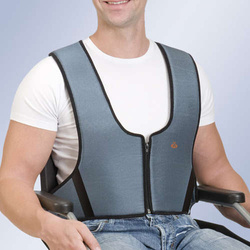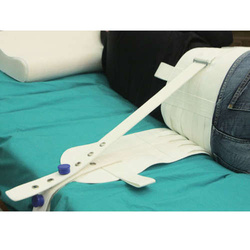Restraint belts
( number of products: 17 )Restraint belts for controlling involuntary movement
Whether you suffer from an involuntary movement condition or have had an operation that requires you to remain immobile during the recovery process, a belt restraint will aid in immobilization, ensuring proper patient care.
Restraint belts - who are they for?
Restraint belts are most commonly used on patients who are not allowed to move on their own and should be looked after by medical staff or doctors. These patients tend to suffer from mental illnesses as well as dementia senile, Alzheimer's disease or neurological problems which may be caused by a stroke.
Another case in which a belt restraint may be used is for simply limiting mobility. In this situation, the belt works as a humane restraint to protect you or your child from, for example falling out of bed while sleeping, and may also be used as a chest stabilizer for people restricted to a wheelchair.
How do restraint belts work?
Due to there being a large variety of restraint belts, how they work strictly depends on what they’re made for. Most belts are primarily made for restraining people who should not move or change positions due to physical or mental conditions, which may also prove to be difficult to control due to the client’s age or illness. Such belts are put on for patient care when there are no doctors or medical staff nearby to watch over the person.
In most cases, the straps that immobilize the patient are equipped with a magnetic key, which cannot be unfastened without the help of medical personnel who are in charge of overseeing the patient.
Some restraint belts protect patients with physical limitations from falling out of bed, especially during sleep or extended periods of unconsciousness. These humane restraints are helpful and comfortable, improving patient care while reducing the risk of additional injury. Restraint belts are also available in a chest model, which may be used as a stabilizer to prevent the patient from sliding out of the wheelchair.
Restraint belts - benefits and models
Depending on your needs, the restraint straps can be fastened by the patient themselves
or by medical personnel with the help of a magnetic key. The second option is most advantageous for physically or psychologically impaired patients who don’t have control over their movements. Any unauthorized person will not be able remove this type of belt, nor loosen or manipulate it in any way.
Every humane restraint meant to immobilize or stabilize the patient is made of comfortable materials that do not cause irritation, nor do they create too much pressure on the restrained patient. For this reason, restraint belts are safe and comfortable regardless of the model chosen.

Abdominal belt for patients with a tendency to slide out of the seat Arnetec Orliman
















